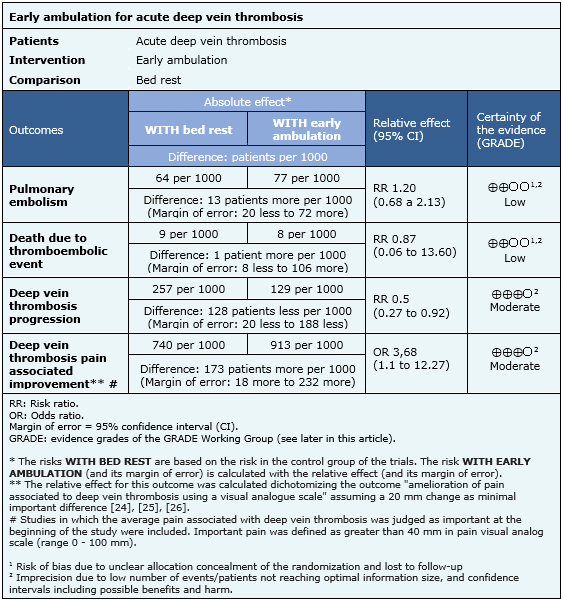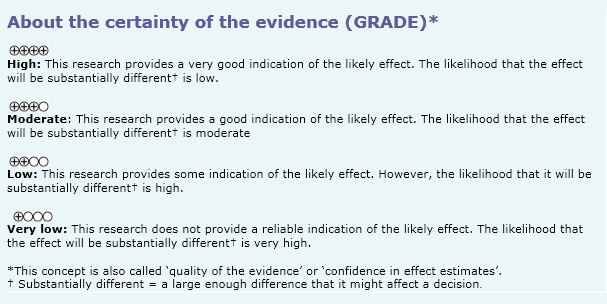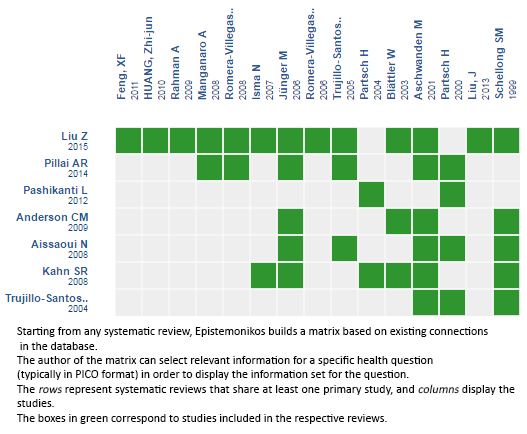 Para Descargar PDF debe Abrir sesión.
Para Descargar PDF debe Abrir sesión.
Aiming to prevent thromboembolic events, bed rest was historically considered in the management of patient with deep vein thrombosis. Nevertheless early ambulation could have beneficial effects. Searching in Epistemonikos database, which is maintained by screening 30 databases, we identified seven systematic reviews including 10 randomized trials answering this question. We combined the evidence using meta-analysis and generated a summary of findings table following the GRADE approach. We concluded early ambulation is probably effective in reducing deep vein thrombosis progression and improving limb pain, and might not increase the risk of thromboembolism.
Bed rest has been considered standard treatment of patients with deep venous thrombosis based on the assumption that rest decreases the risk of deep venous thrombus detachment and subsequent pulmonary embolism [1]. However, bed rest may have negative consequences, such as work absenteeism or morbidity associated with immobilization. In this context, it has been proposed that early mobilization might be a better alternative for these patients.
We used Epistemonikos database, which is maintained by screening more than 30 databases, to identify systematic reviews and their included primary studies. With this information we generated a structured summary using a pre-established format, which includes key messages, a summary of the body of evidence (presented as an evidence matrix in Epistemonikos), meta-analysis of the total of studies, a summary of findings table following the GRADE approach and a table of other considerations for decision-making.
|
Key messages
|
|
What is the evidence. |
We found seven systematic reviews [2],[3],[4],[5],[6],[7],[8] considering 13 primary studies [9],[10],[11],[12],[13], [14],[15],[16],[17],[18],[19],[20],[21],[22],[23] including 10 randomized controlled trials [9],[10],[11],[12],[13],[14],[15],[16],[17],[18],[19],[20] and three observational studies [21],[22],[23]. This table and the analysis as a whole is based on the randomized controlled trials. |
|
What types of patients were included |
Patients with a diagnosis of acute deep vein thrombosis. |
|
What types of interventions were included |
Early ambulation compared with forced bed rest. Both strategies were associated with anticoagulation. |
|
What types of outcomes |
Pulmonary thromboembolism, death due to thromboembolic event, deep vein thrombosis progression and pain associated with deep vein thrombosis. |
The information about the effects of early ambulation on deep vein thrombosis is based on 10 randomized controlled trials including 927 patients. Eight randomized controlled trials reported incidence of pulmonary embolism (including 863 patients), three trials reported death due to thromboembolic event (including 231 patients), three trials reported deep vein thrombosis progression (including 171 patients) and five trials reported pain associated with deep vein thrombosis (including 287 patients). The summary of findings is the following:


|
To whom this evidence does and does not apply |
|
| About the outcomes included in this summary |
|
| Balance between benefits and risks, and certainty of the evidence |
|
| What would patients and their doctors think about this intervention |
|
| Resource considerations |
|
|
Differences between this summary and other sources |
|
| Could this evidence change in the future? |
|
Using automated and collaborative means, we compiled all the relevant evidence for the question of interest and we present it as a matrix of evidence.

Follow the link to access the interactive version: Early mobilization versus bed rest for deep vein thrombosis
The upper portion of the matrix of evidence will display a warning of “new evidence” if new systematic reviews are published after the publication of this summary. Even though the project considers the periodical update of these summaries, users are invited to comment in Medwave or to contact the authors through email if they find new evidence and the summary should be updated earlier. After creating an account in Epistemonikos, users will be able to save the matrixes and to receive automated notifications any time new evidence potentially relevant for the question appears.
The details about the methods used to produce these summaries are described here http://dx.doi.org/10.5867/medwave.2014.06.5997.
Epistemonikos foundation is a non-for-profit organization aiming to bring information closer to health decision-makers with technology. Its main development is Epistemonikos database (www.epistemonikos.org).
These summaries follow a rigorous process of internal peer review.
Conflicts of interest
The authors do not have relevant interests to declare.
 Esta obra de Medwave está bajo una licencia Creative Commons Atribución-NoComercial 3.0 Unported. Esta licencia permite el uso, distribución y reproducción del artículo en cualquier medio, siempre y cuando se otorgue el crédito correspondiente al autor del artículo y al medio en que se publica, en este caso, Medwave.
Esta obra de Medwave está bajo una licencia Creative Commons Atribución-NoComercial 3.0 Unported. Esta licencia permite el uso, distribución y reproducción del artículo en cualquier medio, siempre y cuando se otorgue el crédito correspondiente al autor del artículo y al medio en que se publica, en este caso, Medwave.

Aiming to prevent thromboembolic events, bed rest was historically considered in the management of patient with deep vein thrombosis. Nevertheless early ambulation could have beneficial effects. Searching in Epistemonikos database, which is maintained by screening 30 databases, we identified seven systematic reviews including 10 randomized trials answering this question. We combined the evidence using meta-analysis and generated a summary of findings table following the GRADE approach. We concluded early ambulation is probably effective in reducing deep vein thrombosis progression and improving limb pain, and might not increase the risk of thromboembolism.
 Autores:
Ariel Izcovich[1,2], Federico Popoff[1,2], Gabriel Rada[3,4,5,6,7]
Autores:
Ariel Izcovich[1,2], Federico Popoff[1,2], Gabriel Rada[3,4,5,6,7]

Citación: Izcovich A, Popoff F, Rada G. Early mobilization versus bed rest for deep vein thrombosis. Medwave 2016;16(Suppl 2):e6478 doi: 10.5867/medwave.2016.6478
Fecha de publicación: 28/6/2016

Nos complace que usted tenga interés en comentar uno de nuestros artículos. Su comentario será publicado inmediatamente. No obstante, Medwave se reserva el derecho a eliminarlo posteriormente si la dirección editorial considera que su comentario es: ofensivo en algún sentido, irrelevante, trivial, contiene errores de lenguaje, contiene arengas políticas, obedece a fines comerciales, contiene datos de alguna persona en particular, o sugiere cambios en el manejo de pacientes que no hayan sido publicados previamente en alguna revista con revisión por pares.
Aún no hay comentarios en este artículo.
Para comentar debe iniciar sesión
 Medwave publica las vistas HTML y descargas PDF por artículo, junto con otras métricas de redes sociales.
Medwave publica las vistas HTML y descargas PDF por artículo, junto con otras métricas de redes sociales.
 Galanaud JP, Laroche JP, Righini M. The history and historical treatments of deep vein thrombosis. J Thromb Haemost. 2013 Mar;11(3):402-11.
| CrossRef | PubMed |
Galanaud JP, Laroche JP, Righini M. The history and historical treatments of deep vein thrombosis. J Thromb Haemost. 2013 Mar;11(3):402-11.
| CrossRef | PubMed | Aissaoui N, Martins E, Mouly S, Weber S, Meune C. A meta-analysis of bed rest versus early ambulation in the management of pulmonary embolism, deep vein thrombosis, or both. Int J Cardiol. 2009 Sep 11;137(1):37-41. | CrossRef | PubMed |
Aissaoui N, Martins E, Mouly S, Weber S, Meune C. A meta-analysis of bed rest versus early ambulation in the management of pulmonary embolism, deep vein thrombosis, or both. Int J Cardiol. 2009 Sep 11;137(1):37-41. | CrossRef | PubMed | Kalisch BJ, Lee S, Dabney BW. Outcomes of inpatient mobilization: a literature review. J Clin Nurs. 2014 Jun;23(11-12):1486-501. | CrossRef | PubMed |
Kalisch BJ, Lee S, Dabney BW. Outcomes of inpatient mobilization: a literature review. J Clin Nurs. 2014 Jun;23(11-12):1486-501. | CrossRef | PubMed | Anderson CM, Overend TJ, Godwin J, Sealy C, Sunderji A. Ambulation after deep vein thrombosis: a systematic review. Physiother Can. 2009 Summer;61(3):133-40. | CrossRef | PubMed |
Anderson CM, Overend TJ, Godwin J, Sealy C, Sunderji A. Ambulation after deep vein thrombosis: a systematic review. Physiother Can. 2009 Summer;61(3):133-40. | CrossRef | PubMed | Kahn SR, Shrier I, Kearon C. Physical activity in patients with deep venous thrombosis: a systematic review. Thromb Res. 2008;122(6):763-73. | PubMed |
Kahn SR, Shrier I, Kearon C. Physical activity in patients with deep venous thrombosis: a systematic review. Thromb Res. 2008;122(6):763-73. | PubMed | Liu Z, Tao X, Chen Y, Fan Z, Li Y. Bed rest versus early ambulation with standard anticoagulation in the management of deep vein thrombosis: a meta-analysis. PLoS One. 2015 Apr 10;10(4):e0121388. | CrossRef | PubMed |
Liu Z, Tao X, Chen Y, Fan Z, Li Y. Bed rest versus early ambulation with standard anticoagulation in the management of deep vein thrombosis: a meta-analysis. PLoS One. 2015 Apr 10;10(4):e0121388. | CrossRef | PubMed | Pillai AR, Raval JS. Does early ambulation increase the risk of pulmonary embolism in deep vein thrombosis? A review of the literature. Home Healthc Nurse. 2014 Jun;32(6):336-42. | CrossRef | PubMed |
Pillai AR, Raval JS. Does early ambulation increase the risk of pulmonary embolism in deep vein thrombosis? A review of the literature. Home Healthc Nurse. 2014 Jun;32(6):336-42. | CrossRef | PubMed | Trujillo-Santos AJ, Martos-Pérez F, Perea-Milla E. [Bed rest or early mobilization as treatment of deep vein thrombosis: a systematic review and meta-analysis]. Med Clin (Barc). 2004 May 8;122(17):641-7. | PubMed |
Trujillo-Santos AJ, Martos-Pérez F, Perea-Milla E. [Bed rest or early mobilization as treatment of deep vein thrombosis: a systematic review and meta-analysis]. Med Clin (Barc). 2004 May 8;122(17):641-7. | PubMed | Aschwanden M, Labs KH, Engel H, Schwob A, Jeanneret C, Mueller-Brand J, et al. Acute deep vein thrombosis: early mobilization does not increase the frequency of pulmonary embolism. Thromb Haemost. 2001 Jan;85(1):42-6. | PubMed |
Aschwanden M, Labs KH, Engel H, Schwob A, Jeanneret C, Mueller-Brand J, et al. Acute deep vein thrombosis: early mobilization does not increase the frequency of pulmonary embolism. Thromb Haemost. 2001 Jan;85(1):42-6. | PubMed | Romera A C-CM, Pérez-Piqueras A, Martí-Mestre FX, Bonell-Pascual A, Lapiedra-Mur O. La movilización precoz en pacientes con trombosis venosa profunda aguda no aumenta el riesgo de embolismo pulmonar sintomático. ANGIOLOGÍA. 2006;58(2):127-35. | Link |
Romera A C-CM, Pérez-Piqueras A, Martí-Mestre FX, Bonell-Pascual A, Lapiedra-Mur O. La movilización precoz en pacientes con trombosis venosa profunda aguda no aumenta el riesgo de embolismo pulmonar sintomático. ANGIOLOGÍA. 2006;58(2):127-35. | Link | Blättler W, Partsch H. Leg compression and ambulation is better than bed rest for the treatment of acute deep venous thrombosis. Int Angiol. 2003 Dec;22(4):393-400. | PubMed |
Blättler W, Partsch H. Leg compression and ambulation is better than bed rest for the treatment of acute deep venous thrombosis. Int Angiol. 2003 Dec;22(4):393-400. | PubMed | Isma N, Johanssson E, Björk A, Björgell O, Robertson F, Mattiasson I,et al. Does supervised exercise after deep venous thrombosis improve recanalization of occluded vein segments? A randomized study. J Thromb Thrombolysis. 2007 Feb;23(1):25-30. | PubMed |
Isma N, Johanssson E, Björk A, Björgell O, Robertson F, Mattiasson I,et al. Does supervised exercise after deep venous thrombosis improve recanalization of occluded vein segments? A randomized study. J Thromb Thrombolysis. 2007 Feb;23(1):25-30. | PubMed | Jünger M, Diehm C, Störiko H, Hach-Wunderle V, Heidrich H, Karasch T, et al. Mobilization versus immobilization in the treatment of acute proximal deep venous thrombosis: a prospective, randomized, open, multicentre trial. Curr Med Res Opin. 2006 Mar;22(3):593-602. | PubMed |
Jünger M, Diehm C, Störiko H, Hach-Wunderle V, Heidrich H, Karasch T, et al. Mobilization versus immobilization in the treatment of acute proximal deep venous thrombosis: a prospective, randomized, open, multicentre trial. Curr Med Res Opin. 2006 Mar;22(3):593-602. | PubMed | Liu, J, Liu, T, Wan, Y, Zou, XM, Liu, QQ. Effect of early functional training on acute deep venous thrombosis of patients with stroke. Chinese Journal of Rehabilitation. 2013;28(2):117-119. | Link |
Liu, J, Liu, T, Wan, Y, Zou, XM, Liu, QQ. Effect of early functional training on acute deep venous thrombosis of patients with stroke. Chinese Journal of Rehabilitation. 2013;28(2):117-119. | Link | Partsch H, Blättler W. Compression and walking versus bed rest in the treatment of proximal deep venous thrombosis with low molecular weight heparin. J Vasc Surg. 2000 Nov;32(5):861-9. | PubMed |
Partsch H, Blättler W. Compression and walking versus bed rest in the treatment of proximal deep venous thrombosis with low molecular weight heparin. J Vasc Surg. 2000 Nov;32(5):861-9. | PubMed | Partsch H1, Kaulich M, Mayer W. Immediate mobilisation in acute vein thrombosis reduces post-thrombotic syndrome. Int Angiol. 2004 Sep;23(3):206-12.
| PubMed |
Partsch H1, Kaulich M, Mayer W. Immediate mobilisation in acute vein thrombosis reduces post-thrombotic syndrome. Int Angiol. 2004 Sep;23(3):206-12.
| PubMed | Rahman A, Colak MC, Ustünel L, Koc M, Kocakoc E, Colak C. A comparison of different treatment managements in patients with acute deep vein thrombosis by the effects on enhancing venous outflow in the lower limb. Med Sci Monit. 2009 Nov;15(11):CR588-93. | PubMed |
Rahman A, Colak MC, Ustünel L, Koc M, Kocakoc E, Colak C. A comparison of different treatment managements in patients with acute deep vein thrombosis by the effects on enhancing venous outflow in the lower limb. Med Sci Monit. 2009 Nov;15(11):CR588-93. | PubMed | Romera-Villegas A1, Cairols-Castellote MA, Vila-Coll R, Gómez AP, Martí-Mestre X, Bonell-Pascual A, et al. Early mobilisation in patients with acute deep vein thrombosis does not increase the risk of a symptomatic pulmonary embolism. Int Angiol. 2008 Dec;27(6):494-9. | PubMed |
Romera-Villegas A1, Cairols-Castellote MA, Vila-Coll R, Gómez AP, Martí-Mestre X, Bonell-Pascual A, et al. Early mobilisation in patients with acute deep vein thrombosis does not increase the risk of a symptomatic pulmonary embolism. Int Angiol. 2008 Dec;27(6):494-9. | PubMed | Schellong SM, Schwarz T, Kropp J, Prescher Y, Beuthien-Baumann B, Daniel WG. Bed rest in deep vein thrombosis and the incidence of scintigraphic pulmonary embolism. Thromb Haemost. 1999 Sep;82 Suppl 1:127-9. | PubMed |
Schellong SM, Schwarz T, Kropp J, Prescher Y, Beuthien-Baumann B, Daniel WG. Bed rest in deep vein thrombosis and the incidence of scintigraphic pulmonary embolism. Thromb Haemost. 1999 Sep;82 Suppl 1:127-9. | PubMed | Huang ZJ, Qu LF, Jing ZP, Liu AF, Yuan XL. A randomized controlled prospective study on ambulation versus bed rest for the initial treatment of patients with acute deep venous thrombosis. Chin J Gen Surg. 2010(9):737-739. | CrossRef |
Huang ZJ, Qu LF, Jing ZP, Liu AF, Yuan XL. A randomized controlled prospective study on ambulation versus bed rest for the initial treatment of patients with acute deep venous thrombosis. Chin J Gen Surg. 2010(9):737-739. | CrossRef | Manganaro A, Ando G, Lembo D, Sutera Sardo L, Buda D. A retrospective analysis of hospitalized patients with documented deep-venous thrombosis and their risk of pulmonary embolism. Angiology. 2008 Oct-Nov;59(5):599-604. | CrossRef | PubMed |
Manganaro A, Ando G, Lembo D, Sutera Sardo L, Buda D. A retrospective analysis of hospitalized patients with documented deep-venous thrombosis and their risk of pulmonary embolism. Angiology. 2008 Oct-Nov;59(5):599-604. | CrossRef | PubMed | Trujillo-Santos J, Perea-Milla E, Jiménez-Puente A, Sánchez-Cantalejo E, del Toro J, Grau E, et al. Bed rest or ambulation in the initial treatment of patients with acute deep vein thrombosis or pulmonary embolism: findings from the RIETE registry. Chest. 2005 May;127(5):1631-6. | PubMed |
Trujillo-Santos J, Perea-Milla E, Jiménez-Puente A, Sánchez-Cantalejo E, del Toro J, Grau E, et al. Bed rest or ambulation in the initial treatment of patients with acute deep vein thrombosis or pulmonary embolism: findings from the RIETE registry. Chest. 2005 May;127(5):1631-6. | PubMed | Feng. Early walking for treatment of acute deep vein thrombosis. Gems of Health. 2011;8:74,51. | Link |
Feng. Early walking for treatment of acute deep vein thrombosis. Gems of Health. 2011;8:74,51. | Link | Landorf KB, Radford JA, Hudson S. Minimal Important Difference (MID) of two commonly used outcome measures for foot problems. J Foot Ankle Res. 2010 May 14;3:7. | CrossRef | PubMed |
Landorf KB, Radford JA, Hudson S. Minimal Important Difference (MID) of two commonly used outcome measures for foot problems. J Foot Ankle Res. 2010 May 14;3:7. | CrossRef | PubMed | Lee JS, Hobden E, Stiell IG, Wells GA. Clinically important change in the visual analog scale after adequate pain control. Acad Emerg Med. 2003 Oct;10(10):1128-30. | PubMed |
Lee JS, Hobden E, Stiell IG, Wells GA. Clinically important change in the visual analog scale after adequate pain control. Acad Emerg Med. 2003 Oct;10(10):1128-30. | PubMed | Stauffer ME, Taylor SD, Watson DJ, Peloso PM, Morrison A. Definition of nonresponse to analgesic treatment of arthritic pain: an analytical literature review of the smallest detectable difference, the minimal detectable change, and the minimal clinically important difference on the pain visual analog scale. Int J Inflam. 2011;2011:231926. | CrossRef | PubMed |
Stauffer ME, Taylor SD, Watson DJ, Peloso PM, Morrison A. Definition of nonresponse to analgesic treatment of arthritic pain: an analytical literature review of the smallest detectable difference, the minimal detectable change, and the minimal clinically important difference on the pain visual analog scale. Int J Inflam. 2011;2011:231926. | CrossRef | PubMed | Guyatt GH, Oxman AD, Kunz R, Brozek J, Alonso-Coello P, Rind D, et al. GRADE guidelines 6. Rating the quality of evidence--imprecision. J Clin Epidemiol. 2011 Dec;64(12):1283-93. | CrossRef | PubMed |
Guyatt GH, Oxman AD, Kunz R, Brozek J, Alonso-Coello P, Rind D, et al. GRADE guidelines 6. Rating the quality of evidence--imprecision. J Clin Epidemiol. 2011 Dec;64(12):1283-93. | CrossRef | PubMed | Brajesh K. Lal M. Role of a Novel Exercise Program to Prevent Post-thrombotic Syndrome (EFFORT2). clinicaltrials.gov [on line]. | Link |
Brajesh K. Lal M. Role of a Novel Exercise Program to Prevent Post-thrombotic Syndrome (EFFORT2). clinicaltrials.gov [on line]. | Link |